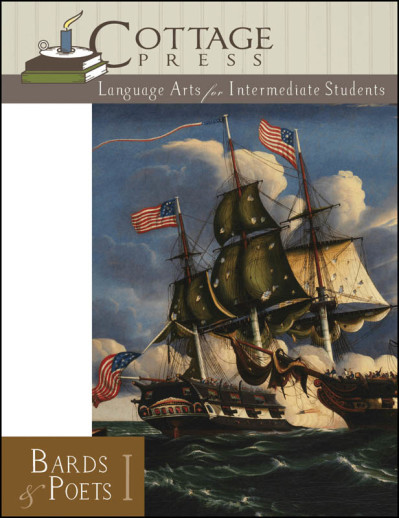We use cookies to make your experience better. To comply with the new e-Privacy directive, we need to ask for your consent to set the cookies. Learn more.
Language Arts for Intermediate Students Bards & Poets - Level 1 Student Book
The Bard & Poets program provides twenty-eight weekly lessons in composition, literary analysis, vocabulary development, grammar, usage, and mechanics. This first level follows the Narrative stage of the progymnasmata, and focuses on sentence and paragraph construction skills. Poetry lessons are designed to foster delight as well as identify basic forms and literary devices. Lessons, likewise, include grammar practice (including extensive sentence diagramming) and vocabulary exercises. The Student Book provides instruction directly to the student. It is assumed, however, that the course is being taught by the parent rather than the student working independently. Weekly lessons are laid out in a step-by-step fashion. Background information on poets and authors as well as their works is provided. The student is expected to compile aCommonplace Book where prose and poetry selections are copied. It also becomes a collection place for any literary tidbits or thoughts that surface while completing the lessons. In contrast, the Writer's Journal is the place where the student records vocabulary lessons, works on diagramming sentences, lists literary devices when studied, and completes writing assignments. Instructions for setting up the Writer's Journal and Commonplace Book are included in the appendices of the Student Book. Other appendices include grammar terms and definitions, narrative elements, and a bibliography. 501 pgs, pb.
Required Books & Resources: Bards & Poets Level I Teaching Helps, Sentence Sense, Flashcards (can make your own or use pdf from website), index card box and dividers, and two composition books.
Recommended Literature: Poetry Anthology (Favorite Poems Old & New) and lots of excellent reading selections (i.e. Books, Books, Books).
Recommended Resources: Book of Centuries Historical Timeline Notebook, Quizlet (online flashcard review set), Key to Harvey's Practical English Grammar (suggested for answers to extra exercises; all answers to lesson exercises are included in Teaching Helps), Dictionary (print), Thesaurus, and Rhyming Dictionary.
Twenty-eight grammar and composition lessons. Every lesson includes:
Poetry & Prose—literary analysis: reading and comprehending the basic elements of a story or poem, including characters, setting, plot, story sequence, literary context, poetic rhyme & meter (scansion)
Language Logic—grammar and word usage: grammar lessons applied to sentences from the narrative or poetry selection and coordinated with Harvey's Revised Grammar, vocabulary study, sentence diagramming, and dictation
Eloquent Expression—style development: building copia (abundant and ready supply) of words and construction, paraphrasing, figures of speech, figures of description
Classical Composition—imitation of a worthy literary model: outlining and retelling a narrative, summarizing, and employing the writing sequence (plan, write, revise)
Commonplace Book—a time-honored practice for writers of all ages: collecting and copying worthy literary selections
| Product Format: | Paperback |
|---|---|
| Grades: | 6-12 |
| Brand: | Cottage Press |
| ISBN: | 9781078359641 |
| Length in Inches: | 11 |
| Width in Inches: | 8.5 |
| Height in Inches: | 1.1875 |
| Weight in Pounds: | 2.8 |
My two daughters share the sentence sense, but each have their own student notebooks. There is a lot of writing needed, so they also have divided notebooks.
I don’t have any experience with writing with skill level 1 so I’m not sure. Bards & Poets 2 is roughly 8th grade, and Poetics & Progym roughly 9th. I’d recommend reaching out to cottage press directly to try and compare scope and sequence of both programs.
It all depends on the student's strengths, but we generally read the lesson together, and I pick and choose the sections for them to complete independently. Then we check the work together as a "class". I went through this book with 2 students, so that helped with discussion. I would guess we spend about 1.5 hours a week together and another 1.5 hours a week on their own.


Co-op school requirement
after using IEW for three years, my daughter wanted something different. A friend suggested it and it seems to fit with a Charlotte Mason style of learning.
because it was perfect.
I adore the Primer series. We are currently using Primer 1, honestly as a supplement to our Rod and Staff English (you do NOT need a supplement for Rod and Staff English) program. Our kiddos needed an…